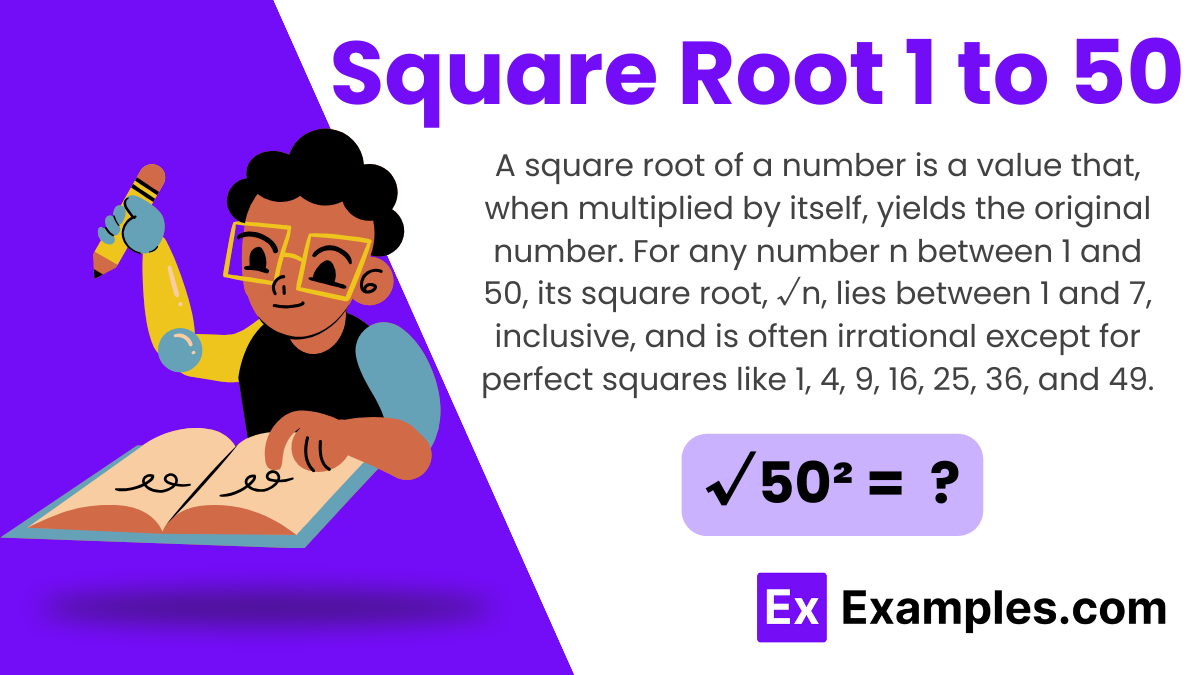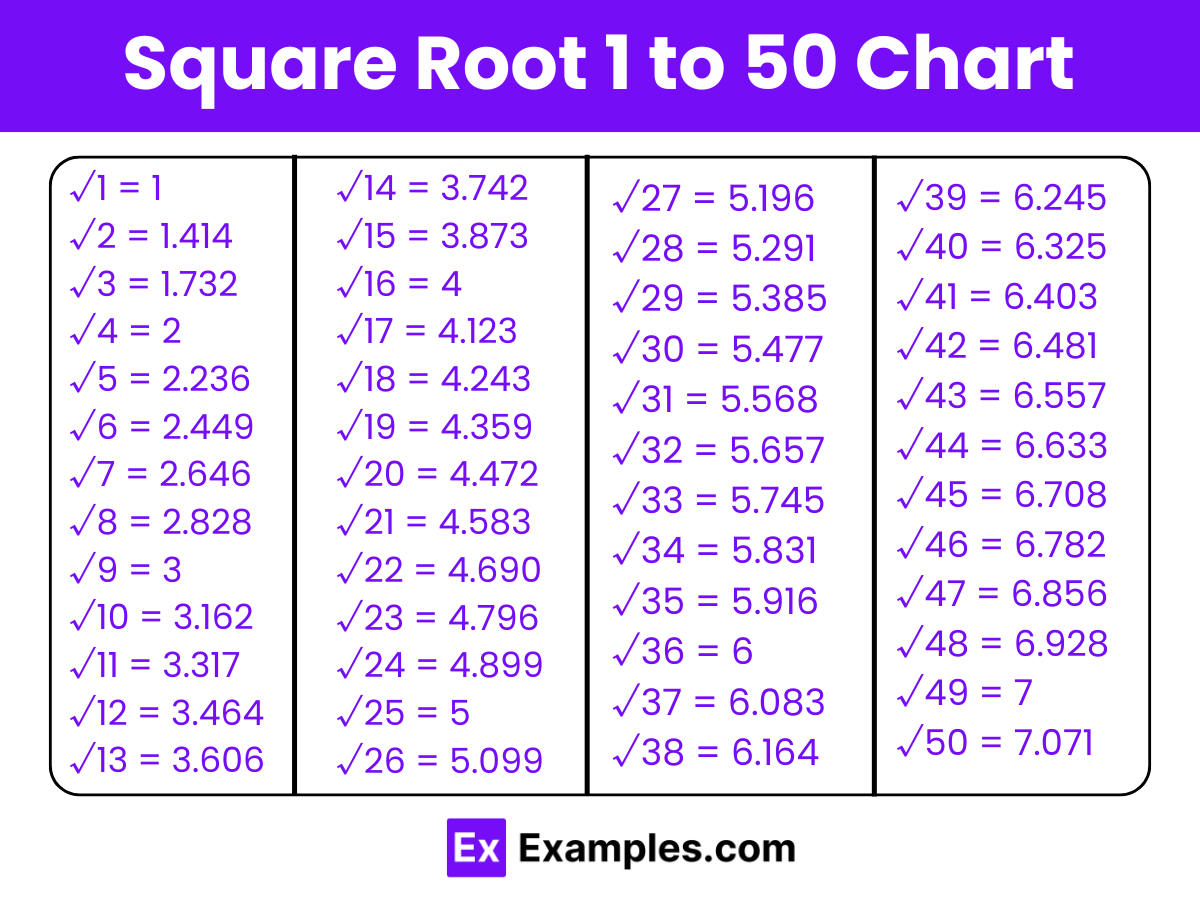What is the square root of 36?
5
6
7
8


The square roots of numbers from 1 to 50 involve both rational and irrational numbers; while perfect squares like 1, 4, 9, 16, 25, 36, and 49 have rational square roots, others are irrational. In algebra, square roots relate to quadratic equations and are vital in solving problems involving squares and their inverses. Integer solutions only exist for perfect squares, while non-perfect squares and square roots. The least squares method, used in statistics, minimizes the sum of squared differences, and roots help in regression analysis. The concept of square roots extends across various mathematical branches, revealing the relationships between numbers in practical and theoretical contexts.
Download Square Root 1 to 50 in PDF
Square roots of numbers from 1 to 50 include both rational (perfect squares) and irrational values. In algebra, they relate to solving quadratic equations, and in statistics, they play a role in the least squares method. Understanding square roots is essential for grasping relationships between numbers in various mathematical contexts.
In exponential form: (x)¹/²
Where x is any number between 1 to 50.

Download Square Root 1 to 50 in PDF
| Square Root | Value |
|---|---|
| √1 | 1 |
| √2 | 1.414 |
| √3 | 1.732 |
| √4 | 2 |
| √5 | 2.236 |
| √6 | 2.449 |
| √7 | 2.646 |
| √8 | 2.828 |
| √9 | 3 |
| √10 | 3.162 |
| √11 | 3.317 |
| √12 | 3.464 |
| √13 | 3.606 |
| √14 | 3.742 |
| √15 | 3.873 |
| √16 | 4 |
| √17 | 4.123 |
| √18 | 4.243 |
| √19 | 4.359 |
| √20 | 4.472 |
| √21 | 4.583 |
| √22 | 4.69 |
| √23 | 4.796 |
| √24 | 4.899 |
| √25 | 5 |
| √26 | 5.099 |
| √27 | 5.196 |
| √28 | 5.292 |
| √29 | 5.385 |
| √30 | 5.477 |
| √31 | 5.568 |
| √32 | 5.657 |
| √33 | 5.745 |
| √34 | 5.831 |
| √35 | 5.916 |
| √36 | 6 |
| √37 | 6.083 |
| √38 | 6.164 |
| √39 | 6.245 |
| √40 | 6.325 |
| √41 | 6.403 |
| √42 | 6.481 |
| √43 | 6.557 |
| √44 | 6.633 |
| √45 | 6.708 |
| √46 | 6.782 |
| √47 | 6.855 |
| √48 | 6.928 |
| √49 | 7 |
| √50 | 7.071 |
This list shows approximate square root values from √1 to √50, identifying both rational and irrational numbers. Perfect squares have whole number square roots, while others provide approximate decimal values that help in practical calculations and understanding the magnitude of these numbers.
| Number | Square Root |
|---|---|
| √1 | 1 |
| √4 | 2 |
| √9 | 3 |
| √16 | 4 |
| √25 | 5 |
| √36 | 6 |
| √49 | 7 |
This table lists the perfect square numbers from 1 to 50 alongside their respective square roots. Perfect squares are numbers that result from multiplying an integer by itself, thus their square roots are integers.
| Number | Square Root |
|---|---|
| √2 | 1.414 |
| √3 | 1.732 |
| √5 | 2.236 |
| √6 | 2.449 |
| √7 | 2.646 |
| √8 | 2.828 |
| √10 | 3.162 |
| √11 | 3.317 |
| √12 | 3.464 |
| √13 | 3.606 |
| √14 | 3.742 |
| √15 | 3.873 |
| √17 | 4.123 |
| √18 | 4.243 |
| √19 | 4.359 |
| √20 | 4.472 |
| √21 | 4.583 |
| √22 | 4.69 |
| √23 | 4.796 |
| √24 | 4.899 |
| √26 | 5.099 |
| √27 | 5.196 |
| √28 | 5.292 |
| √29 | 5.385 |
| √30 | 5.477 |
| √31 | 5.568 |
| √32 | 5.657 |
| √33 | 5.745 |
| √34 | 5.831 |
| √35 | 5.916 |
| √37 | 6.083 |
| √38 | 6.164 |
| √39 | 6.245 |
| √40 | 6.325 |
| √41 | 6.403 |
| √42 | 6.481 |
| √43 | 6.557 |
| √44 | 6.633 |
| √45 | 6.708 |
| √46 | 6.782 |
| √47 | 6.855 |
| √48 | 6.928 |
| √50 | 7.071 |
This table provides the square roots of non-perfect squares from 1 to 25. Each entry shows a number and its corresponding square root value.
To calculate the square roots from 1 to 50, you can use these methods:
The simplest way to calculate square roots is by using a scientific calculator or a calculator app, which provides immediate and accurate results.
The Long Division method involves dividing the number into pairs of digits from the decimal point and iteratively finding digits that, when squared, don’t exceed the pair, which approximates the square root.
For approximations, you can interpolate between known perfect squares or use numerical algorithms like the Babylonian method to iteratively refine the estimate.
A number has a rational square root if it is a perfect square (e.g., 1, 4, 9), otherwise, it has an irrational square root.
In statistics, square roots are used in the least squares method to minimize the sum of squared deviations, aiding in linear regression and measuring data spread (standard deviation).
Text prompt
Add Tone
10 Examples of Public speaking
20 Examples of Gas lighting
What is the square root of 36?
5
6
7
8
What number squared equals 49?
6
7
8
9
What is the square root of 30 (approximately)?
5.2
5.4
5.5
5.8
Which number, when squared, equals 81?
8
9
10
11
Which of the following numbers is the square root of 49?
5
6
7
8
What number squared equals 25?
4
5
6
7
What is the approximate square root of 3?
1.5
1.6
1.7
1.8
What is the square root of 9?
2
3
4
5
What is the square root of 2 (approximately)?
1.3
1.4
1.5
1.6
Which of the following numbers is the square root of
4.7
4.8
4.9
5.0
Before you leave, take our quick quiz to enhance your learning!

